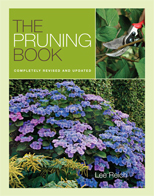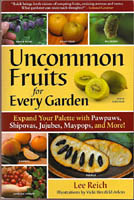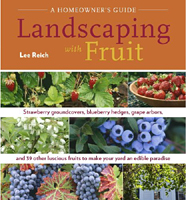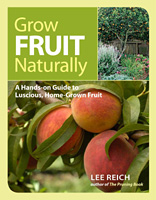Read the Book, Bro’
/12 Comments/in Design, Gardening, Pruning/by Lee ReichTo Prune or Not To Prune, That is the . . .
So I visited my brother and his family for Thanksgiving. As usual, we walked around his yard to look at his plantings. As usual, he asked my advice, this time about pruning. (As usual, he didn’t want to consult a copy of my book, The Pruning Book, which I had given him a few years ago. “Why read it, when I can just ask you?!” he says.)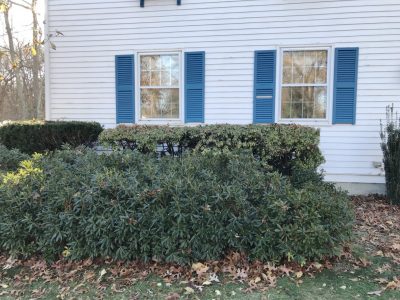
He was considering taking blades to a row of handsome, evergreen shrubs along the front of his house. Over the years, the lengthening branches had sprawled out to encroach upon the bordering lawn, in some places leaving exposed bare stems. He questioned whether new growth would sprout if he lopped all those sprawling stems back to near the roots.
But what was the plant? I had an excuse, admittedly rather lame, for not knowing it: I learned all my ornamentals in Wisconsin where not many broadleaf evergreens are hardy. No matter. Sometimes you can figure out how to prune an unknown plant by just studying its growth habit.
Many evergreens, including most pines, Douglas firs, rosemary, and some rhododendrons, will not sprout new growth if cut back to bare old wood. (At the other extreme are boxwoods and yews, which sprout all over the place no matter how they are cut back.)
I suggested going ahead with drastic pruning of the unknown shrub. My confidence came from seeing many young sprouts emerging from the old stems right near where they emerged from the ground and then bent over from their own weight. Hormones within plants promote sprouting of vigorous, new shoots near the high point of a stem wherever it bends over. Pruning a stem back likewise promotes sprouting right near the cut.
I Pass Judgement
Looking across the front path, bro’ next asked me how I liked the pruning job he’d done on his rhododendrons. Hmmm, pretty good.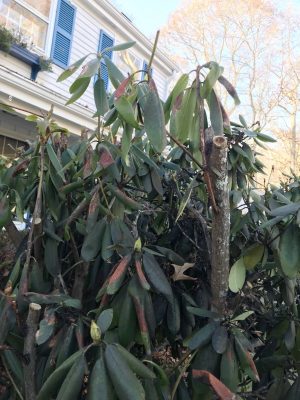
As often happens with rhododendrons, they are planted near a home and then too often grow so large as to swallow up windows, even the whole side of the home. His had done so, and he had pruned stems back to the height he wanted.
Two problems with this pruning. First, as noted above, when a stem is pruned back, most regrowth, and the most vigorous regrowth, occurs just below the cut. So although he cut the plant down to size, he should expect it to start growing back up to its previous size quickly.
The other problem with this pruning is that it leaves the plant looking butchered, large wounds gaping out atop thick stems whose upward mobility has been abruptly stopped. The best pruning jobs are ones where a plant looks nice without looking as if it has even been pruned.
My approach would have been to make a few cuts of the largest stems down in the interior of the shrub, where the stems originated. The largest stems would also be the tallest ones, so such cuts would be effective in lowering the plant. If too many need removal at once, the operation could be spread over 2 or 3 years. Then the pruning cuts would hardly be noticed, and letting light down low among the stems would promote healthy new growth starting low.
With all that said, my brother’s rhodies didn’t look too bad — and he has the opportunity over the next year or two to make my suggested cuts. Lucky for him, his rhodie was not one of the few that are reluctant to make new sprouts in lopped back older wood.
Moving On
Once I get started pruning, it’s sometimes hard to stop. As I looked at his yew shrubs along another part of his house, I suggested paring down the size of that rectangular block of greenery.
Pruning yew is easy. Since it resprouts up and down stems no matter how severely it’s cut, you can do almost anything to it. His large hedge could even be cut down to stumps to begin life anew — quickly, because it has an established root system.
Most important when reducing the size of the hedge, no matter how it’s cut, is to reduce the whole hedge to a size smaller than finally desired. When maintenance trimming a shrub with hedge shears, trimming is generally further out from where the newest shoots began their growth for the season. That’s why hedges grow larger over time, unless they’re periodically lopped back more drastically, which doesn’t leave them looking that good until those cuts are covered by new growth.
And the Mystery Shrub is . . . ?
I don’t feel so at a loss at not being able to identify my brother’s mystery shrub: I sent a photo of it to a few experts, none of whom could identify it.
Of Crocs and Glads
/11 Comments/in Flowers, Gardening/by Lee ReichNo-Dig Crocs
Plants grow and multiply, which sometimes causes trouble. Such trouble was highlighted this week as I was digging up my crocosmia bulbs.
 Backpedaling perhaps 20 years, you would have found me ordering crocosmia bulbs from a mail-order catalog. I’d seen the plants blooming in a friend’s garden in New Jersey and marveled at the graceful flower stems that arched up and out from clumps of sword-shaped leaves. Lined up near the ends of each flower stalk were pairs of tubular, hot scarlet blossoms.
Backpedaling perhaps 20 years, you would have found me ordering crocosmia bulbs from a mail-order catalog. I’d seen the plants blooming in a friend’s garden in New Jersey and marveled at the graceful flower stems that arched up and out from clumps of sword-shaped leaves. Lined up near the ends of each flower stalk were pairs of tubular, hot scarlet blossoms.
Crocosmia isn’t supposed to be cold-hardy outdoors where winter temperatures drop below minus 10 degrees F. (hardiness zone 5), so the first couple of autumns, as instructed, I dug up the bulbs for winter storage. Each spring following, the plants would get off to a slow start, finally blooming late in the season or not at all.
In disappointment or laziness, I stopped digging the bulbs up each fall. I was surprised to see them appear in spring anyway. Not only did they appear in spring; they had some real oomph, growing almost as luxuriantly as the ones in my friend’s garden. To make matters better, they started blooming earlier, in July, and in great profusion, and they have done so reliably year after year with no help at all from me.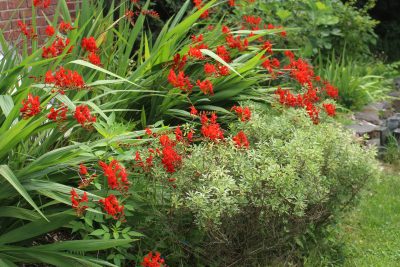
The crocosmias also multiplied, and they did so with such enthusiasm that there became just too many of them at the original location. So I started digging. And I uncovered bulb after bulb after bulb, ready to bloom and multiply next year. Now I have to decide what to do with all those bulbs. Plant them? Give them away? Compost them? I would have never thought I could have had too many crocosmias.
Glads Won’t Die
Does anybody around here still dig up their gladiolas each fall? I don’t, but to no avail. Left outside, they still survive every winter. Yuk. (Gladiolus “bulbs” are, like crocosmia “bulbs,” actually bulb like structured called “corms.”)
I don’t like gladiolas. Perhaps it’s because they are the most popular flower for funerals.
At any rate, I did, for some reason, plant some glads over 30 years go, glads whose beautiful salmon, pink color I subsequently felt was wasted on glad flowers. The nice color couldn’t outweigh the funereal associations, so after a couple of years of digging them up for storage each fall, I decided to sacrifice them to winter cold.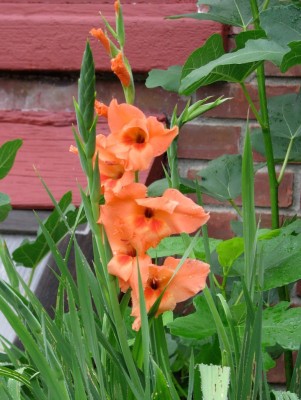
Unfortunately, they reappeared each year, and have continued to do so annually. I have to chuckle whenever I read instructions such as: “Corms should be dug after foliage has matured and started turning brown. Lift corms carefully with a spade or spading fork, taking care not to cut into the corm. Cut the tops off 1inch above the corm and dry for 2 to 4 weeks in a warm location (70-80 degrees Fahrenheit) with good air circulation. Remove the old corm which is beneath the new corm. Discard any rotted or damaged corms. Cut stems back to within an eighth of an inch of the corm. Place the corms in an onion sack or old nylon panty hose. Hang from a wall or ceiling. Ideal storage temperatures are between 35 and 40 degrees Fahrenheit.”
Hah! Doing nothing at all has, unfortunately, worked fine for me. At least the gladiolas haven’t multiplied as fast as the crocosmias.
Cold Air, Not So Cold Soil
The whole concept of winter hardiness for a plant only whose roots (or corms, in the case of crocosmia and gladiola) need to survive winter is hazy. After all, three feet down in the soil almost everywhere, temperatures hover around 50 degrees Fahrenheit.
Lay some mulch on top of any soil and penetration of winter cold can’t reach as deeply as through bare soil or lawn. Bare soil doesn’t peek out anywhere in my garden. Whatever is not lawn has been mulched year after year for many years with leaves, wood chips, sawdust, compost, hay, or whatever other organic materials I can get my hands on. (No, my garden isn’t three feet higher than it was when I started because those organic mulches decompose, enriching the soil as they do so.)
Nonetheless, the ground that the crocosmias and glads call home is well-insulated from winter cold. Warmer winters for the past few years have also helped these “nonhardy” bulbs survive outdoors, especially the less cold-hardy gladiolus.


